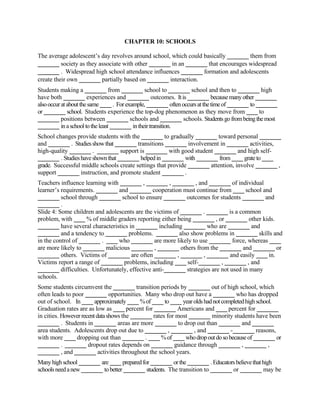
Chapter 10
- 1. CHAPTER 10: SCHOOLS The average adolescent’s day revolves around school, which could basically _______ them from _______ society as they associate with other _______ in an _______ that encourages widespread _______ . Widespread high school attendance influences _______ formation and adolescents create their own _______ partially based on _______ interaction. Students making a _______ from _______ school to _______ school and then to _______ high have both _______ experiences and _______ outcomes. It is _______ because many other _______ also occur at about the same ____ . For example, _______ often occurs at the time of _______ to _______ or _______ school. Students experience the top-dog phenomenon as they move from ____ to _______ positions between _______ schools and _______ schools. Students go from being the most _______ in a school to the least _______ in their transition. School changes provide students with the _______ to gradually _______ toward personal _______ and _______ . Studies show that _______ transitions _______ involvement in _______ activities, high-quality _______ . _______ support is _______ with good student _______ and high self- _______ . Studies have shown that _______ helped in _______ with _______ from ____ grate to ____ grade. Successful middle schools create settings that provide _______ attention, involve _______ , support _______ instruction, and promote student _______ . Teachers influence learning with _______ , _______ , _______ , and _______ of individual learner’s requirements. _______ and _______ cooperation must continue from ____ school and _______ school through _______ school to ensure _______ outcomes for students _______ and _______ . Slide 4: Some children and adolescents are the victims of _______ . _______ is a common problem, with ____ % of middle graders reporting either being _______ , or _______ other kids. _______ have several characteristics in _______ including _______ who are _______ and _______ and a tendency to _______ problems. _______ also show problems in _______ skills and in the control of _______ . ____ who _______ are more likely to use _______ force, whereas ____ are more likely to _______ malicious _______ , _______ others from the _______ and _______ or _______ others. Victims of _______ are often _______ , _______ , _______ and easily ____ in. Victims report a range of _______ problems, including ____ self-_______ , _______ , and _______ difficulties. Unfortunately, effective anti-_______ strategies are not used in many schools. Some students circumvent the _______ transition periods by _______ out of high school, which often leads to poor _______ opportunities. Many who drop out have a _______ who has dropped out of school. In ____ approximately ____ % of ____ to ____ year olds had not completed high school. Graduation rates are as low as ____ percent for _______ Americans and ____ percent for _______ in cities. However recent data shows the _______ rates for most _______ minority students have been _______ . Students in _______ areas are more _______ to drop out than _______ and _______ area students. Adolescents drop out due to _______ , _______ , and _______ -_______ reasons, with more ____ dropping out than _______ . ____ % of ____ who drop out do so because of _______ or _______ . _______ dropout rates depends on _______ guidance through _______ , _______ , _______ , and _______ activities throughout the school years. Many high school _______ are ____ prepared for _______ or the _______ . Educators believe that high schools need a new _______ to better _______ students. The transition to _______ or _______ may be
- 2. less _______ due to improved _______ with _______ . The transition from high school to _______ can be _______ best with _______ assistance from high school _______ and college _______ . U.S. colleges train many students to develop _______ skills rather than _______ specific skills. Major _______ want their new ____ to have the ability to ____ at a high level, _______ effectively, use ____ for straight forward ____ such as word _______ and work effectively with people of _______ backgrounds. Students from low _______ status (____ ) neighborhoods attend schools with _______ graduation rates; _______ students going to _______ ; and _______ , inexperienced _______ . _______ and ____ are often difficult to _______ by themselves because many _______ group members experience _______ . _______ programs often reflect _______ of institutional _______ . _______ for resolving these difficulties are _______ . Student relations in _______ diverse classrooms may be achieved by creating _______ classrooms, encouraging _______ personal contact, advocating _______ taking, promoting _______ thinking and social _______ solving, establishing _______ school-community efforts, and advocating for knowledge and respect of ethnic attitudes. Educators and schools are continuously challenged to support diverse learners within local educational settings. Exceptional adolescents represent students who _______ require curriculum _______ and adult _______ to reach their full _______ . Students with a learning disability most often have difficulties in _______ , _______ language, and _______ . Students with Attention Deficit/Hyperactivity Disorder (ADHD) have difficulties focusing on _______ environmental _______ and show high levels of physical _______ . About ____ percent take prescription medication for behavior _______ . Adolescents with _______ typically are included in _______ education classrooms, the least _______ environment. _______ in _______ education classrooms ensures that all students have the same _______ to ____ both _______ and _______ . Adolescents who are _______ demonstrate characteristics of precocity, _______ in learning, and internal _______ . Programs for _______ students include _______ classes, _______ regular education settings, _______ programs, and community _______ .